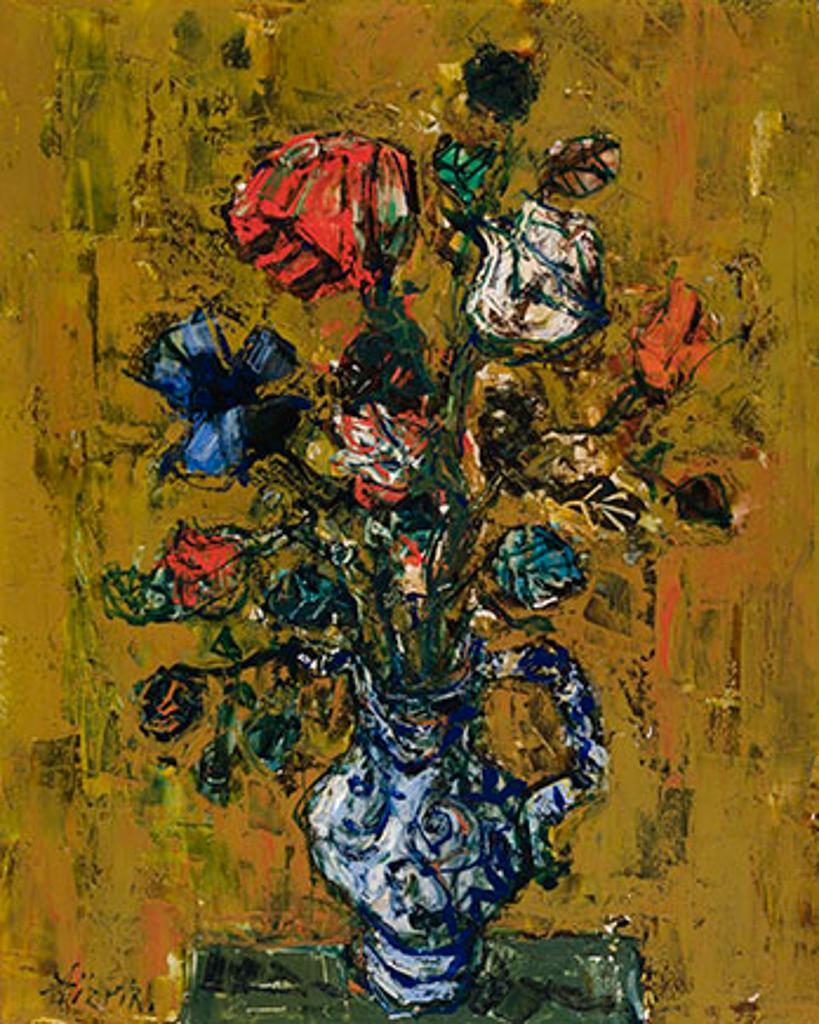
Flowers in a Vase
73 cms x 59.7 cms (28.75 ins x 23.5 ins)
Signed and on verso inscribed variously
Lot offered for sale by Heffel, Vancouver at the auction event "April 2020 Online auction" held on Thu, Apr 30, 2020.
Lot 101
Lot 101
Estimate: CAD $15,000 - $20,000
Realised: CAD $15,000
Realised: CAD $15,000
Lot description - from the online catalogue*
Provenance:
Galerie Paul Pétridès, Paris
Private Collection, Ontario
Notes:
Before WW II, a young Paul Augustin Aïzpiri was living and working in the cultural hub of Montparnasse, arguably the epicenter of the art world in Paris at that time. During the war, Aïzpiri escaped a German POW camp in Brittany and eventually returned to Paris. By 1946, a mature style emerges in his work, distinguished by simple lines, figuration and quotidian subject matter. While not financially successful at first, he gained the respect of his contemporaries such as Bernard Buffet, Paul Rebeyrolle, Gaëtan de Rosnay and André Minaux, who like Aïzpiri sought to oppose the elite Parisian salons and the dominance of abstract art. Winning the Prix Corisca in 1948 allowed Aïzpiri to travel to Marseilles, a world vastly different from Paris, which had a profound effect on his art. Throughout the 1950s, a return to figuration saw Aïzpiri’s reputation and critical reception on the rise, and he had many global exhibits, including the Venice Biennale, O’Hana Gallery, London, Wildenstein Gallery, New York, Acosta Gallery, Los Angeles, Laing Gallery, Toronto, to name a few. In the early 1960s he began exhibiting in Japan, where he remains popular, and the Nakata Museum of art museum was established in Onomichi, largely devoted to his his work.
This canvas depicts one of Aïzpiri’s most recurrent motifs and simple pleasures, a still life with flowers. The flowers are rendered with bold outlines and expressionist brushwork, giving them a beauty that is physical and direct.
Galerie Paul Pétridès, Paris
Private Collection, Ontario
Notes:
Before WW II, a young Paul Augustin Aïzpiri was living and working in the cultural hub of Montparnasse, arguably the epicenter of the art world in Paris at that time. During the war, Aïzpiri escaped a German POW camp in Brittany and eventually returned to Paris. By 1946, a mature style emerges in his work, distinguished by simple lines, figuration and quotidian subject matter. While not financially successful at first, he gained the respect of his contemporaries such as Bernard Buffet, Paul Rebeyrolle, Gaëtan de Rosnay and André Minaux, who like Aïzpiri sought to oppose the elite Parisian salons and the dominance of abstract art. Winning the Prix Corisca in 1948 allowed Aïzpiri to travel to Marseilles, a world vastly different from Paris, which had a profound effect on his art. Throughout the 1950s, a return to figuration saw Aïzpiri’s reputation and critical reception on the rise, and he had many global exhibits, including the Venice Biennale, O’Hana Gallery, London, Wildenstein Gallery, New York, Acosta Gallery, Los Angeles, Laing Gallery, Toronto, to name a few. In the early 1960s he began exhibiting in Japan, where he remains popular, and the Nakata Museum of art museum was established in Onomichi, largely devoted to his his work.
This canvas depicts one of Aïzpiri’s most recurrent motifs and simple pleasures, a still life with flowers. The flowers are rendered with bold outlines and expressionist brushwork, giving them a beauty that is physical and direct.
Most realised prices include the Buyer's Premium of 18-25%, but not the HST/GST Tax.
(*) Text and/or Image might be subject matter of Copyright. Check with Heffel auction house for permission to use.
(*) Text and/or Image might be subject matter of Copyright. Check with Heffel auction house for permission to use.